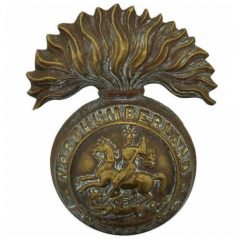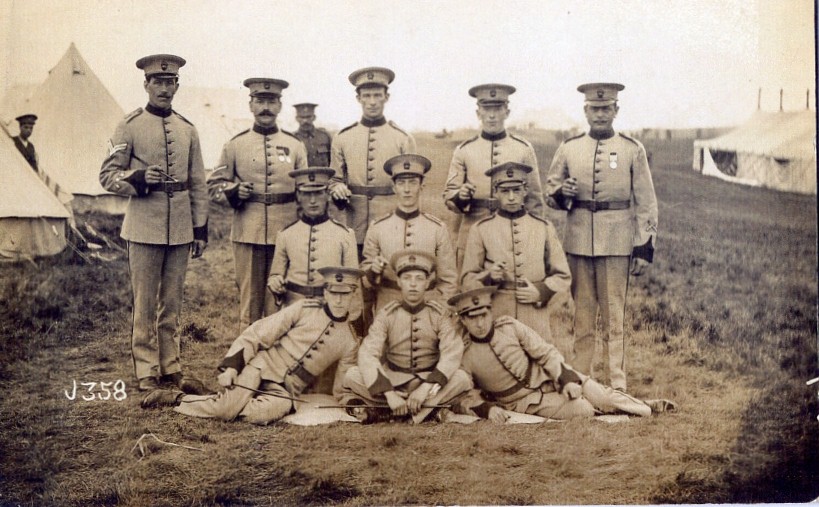The Tynedale district today (www.tynedale.gov.uk) Introduction On the 20th of April 1915, eleven hundred men from the Tynedale district of Northumberland, embarked for the continent with the local volunteer battalion of the Northumberland…
You must be logged in to view the content of this Chapter.
Footnotes
- Crimean War - 1853-1856
- Indian Mutiny – 1857-1859
- Independence from Austria
- The militia could not be compelled to serve overseas, but it was seen as a training reserve for the army, as bounties were offered to men who opted to 'exchange' from the militia to the regular army
- An Ensign was the junior commissioned officer. The junior infantry officer had traditionally carried the ensign flag, so the rank itself acquired the name. The rank has generally been replaced by the 2nd Lieutenant rank
- Oval shaped box
- The shako is a tall, cylindrical military cap, usually with a visor, sometimes tapered at the top and usually adorned with some kind of ornamental plate or badge
- 2nd VB uniform was scarlet with green facings and the 3rd VB, scarlet with white facings
- The 6th Bellingham Corps was raised by William Henry Charlton of Hesleyside Hall near Bellingham
- The Liberals returned to power in 1868 under William Gladstone. Cardwell reached the peak of his career, as Secretary of State for War. During his six years in the post, in what became known as 'Cardwell reforms', Cardwell reorganized the British army, introduced professional standards for officers (including advancement by merit rather than purchase), and formed a home reserve force
- The other two were the 2nd Northumberland Rifle Volunteer Corps and the 1st Newcastle upon Tyne Rifle Volunteer Corps
- English diplomat and essay writer William Temple (1628-1699) negotiated the Triple Alliance (1688) of England, Holland and Sweden against France. William was an outstanding essay writer and retired to Moor Park in Surrey to write his memoirs
- Immediately after the 3rd Anglo-Dutch War 1672 -1674
- The 3rd Viscount Clare was Colonel Daniel O’Brien
- The Army Order of Precedence was first laid down in a Royal Warrant dated 12th September 1666. It was an attempt to settle disputes between the Colonels of regiments over matters of ‘seniority’; of great prestige as it determined the order of regiments in line of battle, on parade, on the march and published lists
- The 6th of Foot became the Warwickshire Regiment
- The term ‘Fusilier’ was originally applied to soldiers armed with a light flintlock musket known as the ‘Fusil’. The original purpose of fusiliers was to act as escort to artillery guns and to maintain discipline amongst the civilian drivers. The Northumberland Fusiliers received the designation relatively late, by which time when there was no specific role or weapons
- The Six Old Corps saw service in the Dutch Army
- Nevertheless, the fusiliers continued to refer to themselves as the ‘Fighting Fifth’
- Newcastle Barracks opened in 1806. The first occupants are thought to have been the North British Dragoons
- 1 Jun 1880. Changed to 1st Northumberland and Berwick on Tweed Volunteer Battalion – 1 Jul 1881. (Order of Precedence No 83)
- 2nd Northumberland Rifle Volunteer Corps: renamed as 2nd Volunteer Battalion in 1883
- 1st Newcastle upon Tyne Rifle Volunteer Corps: renamed as 3rd Volunteer Battalion in 1883
- An infantry company is a subdivision of the battalion. A detailed explanation of the Company system is given later in the narrative
- Henry George Percy, 7th Duke of Northumberland KG, PC, FRS (1846 – 1918) was a Conservative politician. He served as Lord Lieutenant of Northumberland from 1904 until his death in 1918
- Sir Francis Douglas Blake, 1st Baronet CB DL (1856 - 1940) of Tillmouth Park, Cornhill on Tweed was Deputy Lieutenant of Northumberland, Vice Lord Lieutenant in 1920 and 1931, a Justice of the Peace, and a Member of Parliament
- The Depots would also provide drafts of men to the ‘Service’ battalions during WW1
- The 2nd Northumberland Rifle Volunteer Corps was renamed the 2nd Volunteer Battalion, and the 1st Newcastle-on-Tyne Rifle Volunteer Corps was renamed the 3rd Volunteer Battalion in 1883
- The city of Peshawar is at the eastern end of the Khyber Pass in modern day Pakistan
- This is thought to have been Castleton in Derbyshire. For a few summers around the turn of the century Castleton hosted the Annual Camps of Volunteer battalions. The Castleton Historical Society website states that “a very large number of tents were erected in several fields some on the south side of the Winnats Road and some on the north side of the Mam Tor road. Two or three sectional wooden huts acted as headquarters, cookhouse, showers etc. All the water for this large undertaking was pumped by hand directly from the Russet Well. Possibly, but not certainly, the last camp was held in 1905. (Castleton Historical Society)
- The local 4th Battalion of the Yorkshire Regt was part of the "Northumbrian", Division and was under canvas at Deganwy Camp in Wales for the annual Divisional Training.
- Cumberland and Westmorland were amalgamated to form Cumbria in 1974 as a result of the Local Government Act of 1972
- Drift mines take advantage of exposed coal seams on hillsides, rather than driving a shaft down to reach a deep seam. The preference was to exploit a seam running on a slight uphill gradient so rails and gravity could be used to aid the extraction of coal
- History, Topography, and Directory of Northumberland [zotpressInText item="{R7FDSKCN,786}"]
- The district has many associations with the famous engineer George Stephenson, who was married in Newburn Parish Church and worked in the Water Row pit in the village. The village was also the birthplace of steam pioneer William Hedley, whose first locomotive Puffing Billy was built in 1812, two years prior to his rival's first locomotive. The future railway engineers Joseph and George Armstrong both lived in the village from 1824, and found their first employment at nearby Walbottle Colliery
- Northumberland [zotpressInText item="{57T6Q94U,18}"]
- Crossing occupation borders: migration to the north-east of England
- In the Wylam, Ryton and Crawcrook area
- A Vision of Britain through Time (University of Portsmouth)
- 'Landed gentry' was an informal designation referring principally those members of the landowning classes who were not members of the peerage. One belonged to the landed gentry if other members of the class accepted that one did so
- Orderly Room staff
- The primary role of the battalion pioneer’s was to assist in route clearance and minor engineering tasks, such as the construction of field fortifications
- On the battlefield bandsmen performed the role of stretcher-bearers
- Plashetts (Disused Stations)
- The territorials also had new drill halls built in Amble, Ashington and Whitley Bay
- A regular soldier detached from the …. Battalion
- Lt Frederick Swan
- George Hitchiner
- The Maxim gun was first used by Britain's colonial forces in the Rhodesian 1st Matabele War in 1893 and 1894. During the Battle of the Shangani, 50 soldiers fought off 5,000 warriors with just four Maxim guns. They were also used 1898 during the Battle of Omdurman in Sudan
- Subaltern refers to a junior army officer below the rank of captain
- Twenty of the requisite drills were to be completed before the annual camp
- The Alexandra, Princess of Wales Own Regiment is better known as the Green Howards

